
Cerro de Punta or Cerro Punta is the highest peak in Puerto Rico, rising to 1,338 meters (4,390 ft) above sea level. The mountain is part of the Cordillera Central and is located in the municipality of Ponce.
The conservation status of a group of organisms indicates whether the group still exists and how likely the group is to become extinct in the near future. Many factors are taken into account when assessing conservation status: not simply the number of individuals remaining, but the overall increase or decrease in the population over time, breeding success rates, and known threats. Various systems of conservation status are in use at international, multi-country, national and local levels, as well as for consumer use such as sustainable seafood advisory lists and certification. The two international systems are by the International Union for Conservation of Nature (IUCN) and The Convention on International Trade in Endangered Species of Wild Fauna and Flora (CITES).

Desecheo is a small uninhabited island of the archipelago of Puerto Rico in the northeast of the Mona Passage; 13 mi (21 km) from Rincón on the west coast of the main island of Puerto Rico and 31 mi (50 km) northeast of Mona Island. It has a land area of 0.589 sq mi. Politically, the island is administered by the U.S. Department of the Interior, U.S. Fish and Wildlife Service as the Desecheo National Wildlife Refuge, but part of the Sabanetas barrio of Mayagüez.

The Cordillera Central, is the main mountain range in Puerto Rico. The range crosses the island from west to east and divides it into its northern and southern coastal plains. The Cordillera Central runs eastward from the municipality of Maricao in the west to Aibonito in the central eastern region, and on to the Caribbean in the southeast through the Sierra Cayey.
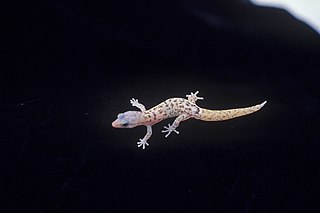
The Monito gecko is a lizard, a species of gecko endemic to the island of Monito, in the archipelago of Puerto Rico.
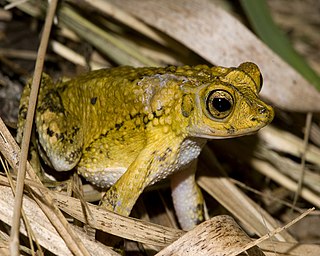
The Puerto Rican crested toad, or simply Puerto Rican toad, is a species of toad found only in Puerto Rico and the Virgin Islands. It is the only species of toad native to Puerto Rico and the Virgin Islands. The species formerly occurred in Virgin Gorda and along the southern and northern karst in Puerto Rico. It is listed as a threatened by the US Fish and Wildlife Service due to habitat loss and introduced species. At one period of time it was believed to be extinct until it was rediscovered in 1966. The IUCN has the species listed as endangered.

Anolis roosevelti, also known commonly as the Virgin Islands giant anole, Roosevelt's giant anole or the Culebra giant anole, is an extremely rare or possibly extinct species of lizard of the genus Anolis in the family Dactyloidae. The species is native to the Virgin Islands and Vieques.

Leptocereus grantianus (sebucan) is a sprawling or suberect, nearly spineless cactus, reaching up to 2 meters in height and 3 to 5 centimeters in diameter. Its elongated stems have from three to five prominent ribs with broadly scalloped edges. Ribs of young joints are thin, and the small areoles or spine-bearing areas may bear from one to three minute, nearly black spines which disappear as the joints grow older. The flowers are solitary at terminal areoles, from 3 to 6 centimeters long, and nocturnal. The outer perianth segments are linear, green, and tipped by an areole like those of the tube and ovary. The inner perianth segments are numerous, cream-colored, oblong-obvate, obtuse, and about 8 millimeters long. The fruit is subglobose to ellipsoid and about 4 centimeters in diameter.
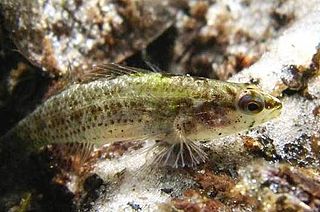
The Okaloosa darter is a species of freshwater ray-finned fish, a darter from the subfamily Etheostomatinae, part of the family Percidae, which also contains the perches, ruffes and pikeperches. It is indigenous to freshwater streams and tributary systems in Okaloosa and Walton Counties in northwest Florida.

Buxus vahlii, or Vahl's boxwood, is a rare species of plant in the boxwood family. It is native to Puerto Rico and St. Croix in the U.S. Virgin Islands, where it is known from no more than four populations total. It has probably never been very common, but its distribution has been reduced by deforestation and other human disturbance of its habitat. At the time it was listed as an endangered species of the United States in 1985, it was thought to be endemic to Puerto Rico. Reports that it existed in Jamaica have not been confirmed. A few individuals have been located in St. Croix, some of which are within Sandy Point National Wildlife Refuge.

Callicarpa ampla, also called the capa rose, is a species of plant in the family Lamiaceae. It is found in Puerto Rico in the Caribbean region. It is threatened by habitat loss and is a critically endangered plant species.

Eugenia woodburyana is a species of plant in the family Myrtaceae. It is endemic to Puerto Rico. It is a federally listed endangered species of the United States. It is threatened by habitat loss.
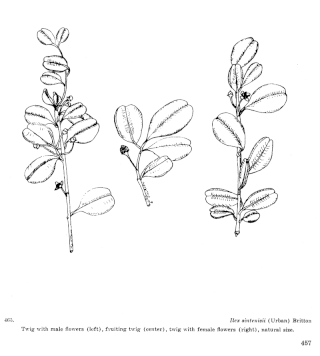
Ilex sintenisii is a species of plant in the family Aquifoliaceae. It is endemic to Puerto Rico. It is threatened by habitat loss. It is a federally listed endangered species of the United States.

Schoepfia arenaria is an extremely rare species of hemiparasitic flowering plant in the Schoepfiaceae family. It grows as a small, multi-trunked tree. It is endemic to Puerto Rico, where it is found growing along the northern coast. A local Spanish vernacular name recorded for this tree is araña ('spider'). It has no common name in English.

Eleutherodactylus juanariveroi, or the Puerto Rican wetland frog, is an endangered species of coqui, a frog species, endemic to Puerto Rico. It was discovered in 2005 by Neftalí Rios, and was named after Puerto Rican herpetologist Juan A. Rivero, in honor of his contributions to Puerto Rican herpetology.

Toro Negro State Forest is one of the 21 forests that make up the public forests system in Puerto Rico. It is also Puerto Rico's highest cloud forest. It is in the Cordillera Central region of the island and covers 8,204 cuerdas, of mountains. Toro Negro's mountains have heights reaching up to 4,400 feet (1,300 m) and include Cerro de Punta, Cerro Jayuya and Cerro Rosa, the three highest peaks in the island. Nested among these mountains is Lake Guineo, the island's highest lake. The forest has 18 kilometers (11 mi) of trails, an observation tower, two natural swimming pools (Spanish:"charcos"), camping and picnic areas, nine rivers, and numerous creeks and waterfalls. The forest spans areas within the municipalities of Ponce, Jayuya, Orocovis, Ciales, and Juana Díaz, and consists of seven non-contiguous tracts of land. The largest contiguous segment of the forest is located in the municipalities of Ponce and Jayuya. Some 40% of the area of Toro Negro State Forest is located in Ponce's Barrio Anón.

The Puerto Rican rock frog, also known as the Puerto Rican cave-dwelling frog or rock coqui, and locally as coquí guajón, or guajón for brevity, is a threatened frog species from the coqui genus. This unique species of tropical frogs dwells primarily in crevices and grottos in the Cuchilla de Panduras mountain range in southeastern Puerto Rico. The native name guajón is derived from its habitat, guajonales, which are caves formed by rock formations between huge stones. Despite being the state animal and considered emblematic of the region, of the 17 species of coquí, three are believed to be extinct and the rest are rare and declining in numbers. The Puerto Rican rock frog is extremely restricted in geographical distribution. The frog is threatened due to deforestation, agricultural, rural, and industrial development, and the associated infrastructure. It is sometimes called the "demon of Puerto Rico" because of its eerie call and phantom-like appearance. The species was first described by American herpetologist, Chapman Grant in 1932.
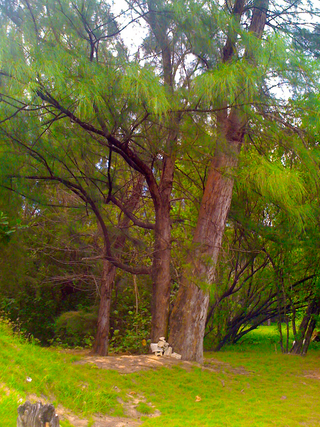
Piñones State Forest,, and named after the Casuarina, locally called Piñones, is a timberland forest near one of the longest beaches in Puerto Rico. It is located in Torrecilla Baja barrio in the municipality of Loíza. It is a tourist attraction and is managed by the Puerto Rico Department of Natural and Environmental Resources.
Cetaceans form an infra-order of marine mammals. In 2020, approximately 86 species of cetaceans had been identified worldwide. Among these species, at least 35 have been sighted in the wider Caribbean region with very widespread distribution and density variations between areas. Caribbean waters are a preferred breeding site for several species of mysticeti, who live further north the rest of the year. The tucuxi and the boto live at the southern periphery of the Caribbean region in the freshwaters of the Amazon River and surrounding drainage basins.


















